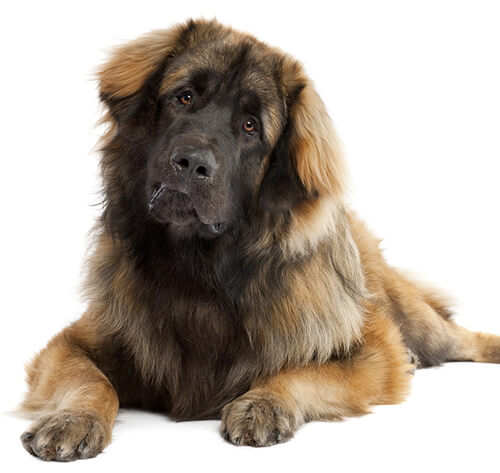
Often called “the gentle giant,” the heavy boned, muscular Leonberger is characterized by his lionlike mane and black mask. This German breed was developed in the mid-1800s as a multipurpose working dog and family companion. The calm, playful Leonberger has a stable temperament and is willing to please. His thick, water-resistant coat should be brushed daily to avoid mats and tangles.
DID YOU KNOW? A cross among the Newfoundland, Great Pyrenees and Saint Bernard, the Leonberger was founded by Heinrich Essig in 1846 in Leonberg, Germany, to exemplify the lion that was featured on Leonberg’s town crest.
The need-to-know
- Dog suitable for experienced owners
- Some training required
- Enjoys active walks
- Enjoys walking an hour a day
- Giant dog
- Heavy drool
- Requires grooming daily
- Non hypoallergenic breed
- Quiet dog
- Guard dog. Barks, alerts and it's physically protective
- May require training to live with other pets
- May require training to live with kids
Personality

Leonbergers should be easy-going, placid, loyal and even-tempered. They get on well with other pets and children and are playful. They learn quickly and, because of their large size, training is especially important and should be started as early as possible.
History and Origins

The Leonberger dog breed was created in the 1840s to resemble the lion of the Leonberg town crest. It is a cross between a Newfoundland and St Bernard, and a backcross to a Pyrenean Mountain Dog. They became very popular and many distinguished people owned them. However, during World War I they almost died out, as people could not afford to feed them. The handful of dogs that were left were bred from carefully until World War II when they were nearly all lost again. Today the Leonberger dog is still relatively rare but it is gaining in number and popularity.
Nutrition and Feeding

Giant-breed dogs, as well as having giant appetites, benefit from a different balance of minerals and vitamins, supporting different joint and cartilage needs. Leonbergers are also prone to bloating and stomach problems; try feeding smaller, more frequent meals to help minimise the risk.
Exercise

As a puppy, this dog should not be over exercised or allowed up and down stairs. When the bones are properly developed then the exercise can be gradually increased. The adult Leonberger dog should have long walks and loves to run around and play. They also have a great love of water and like nothing better than a good swim. A couple of hours' daily exercise is advised for a fit adult.
Other Information

Health and Common Issues
As with many breeds, Leonberger dogs can suffer from various hereditary eye disorders, and hip and elbow dysplasia (joint conditions that can be painful and lead to mobility problems). Eye testing and hip scoring of dogs prior to breeding is therefore important.
Best Family Dog Breeds
While many dogs are traditionally thought of as being good with children, all dogs and children need to be taught to get on with and respect each other, and be safe together. Even so, dogs and young children should never be left alone together and adults should supervise all interactions between them.